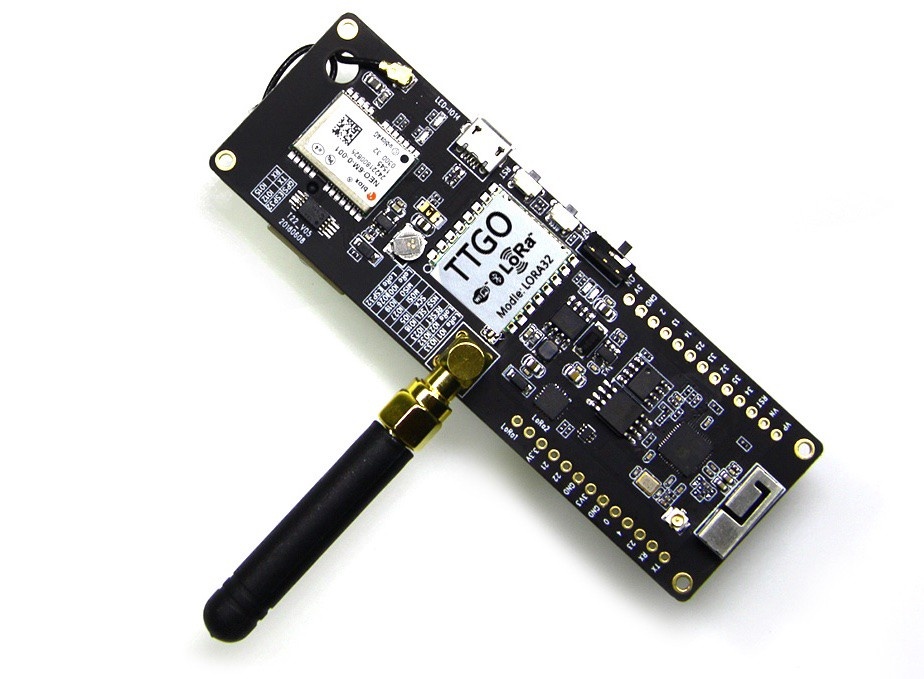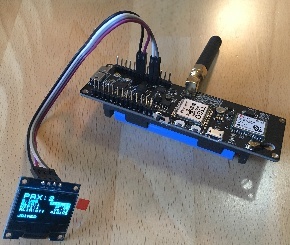Wemos TTGO T-Beam¶
Hardware¶
Micro-controller¶

TTGO T-Beam from Wemos. TTGO T-Beam pinout, example code.
The Wemos TTGO T-Beam is especially suited for mobile operations, because it has an on-board battery holder for an 18650 lithium polymer (LiPo) battery, a GPS receiver, a LoRa transceiver module (using the LoRa chip SX1276) dedicated to the 868 MHz frequency band, and an embedded battery charger. The module is operated by the Espressif ESP32 microcontroller board, which contains a dual-core Xtensa 32bit LX6 processor running with up to 240MHz, 4 MB of flash memory (to store the program code and some files within a file system), and 520 KB of RAM (to store variables, status information, and buffers). The ESP32 module also has built-in WiFi and Bluetooth LE connectivity. In addition, the TTGO T-Beam has 4 MB of PSRAM (pseudo static RAM) that is used as a memory extension for the ESP32. The operating voltage of the board is 3.3V (this is important when attaching sensors and other peripherals; they also must operate on 3.3V). The board offers 18 general purpose input/output pins (18 GPIOs), from which up to 12 can be used as analog input pins (with 12bit analog digital converters (ADC)) and one as analog output pin (8bit digital analog converter (DAC)). Some GPIO pins can be used as serial port (programmable Universal Asynchronous Receiver and Transmitter, UART), I2C port, SPI port, and I2S port. The USB port is connected internally via a USB/Serial converter to another serial port (UART). The WiFi and Bluetooth antenna are mounted on the TTGO T-Beam board. A small GPS antenna is connected via a pigtail to an U.FL / IPX connector. The LoRa antenna has to be connected via an SMA-type connector. The TTGO T-Beam is available from Chinese sellers for around 23 € (I have not found a European shop where it can be bought yet).
The LoRa transmitter and receiver is encapsulated within a LoRa module. It uses the LoRa chip SX1276 from the company Semtech and is dedicated to the 868 MHz frequency band. The LoRa module is connected via SPI interface to the microcontroller and all of the required connections of the LoRa transceiver pins with the microcontroller are already built-in on the TTGO T-Beam board. Since the module only implements the LoRa physical layer, the LoRaWAN protocol stack must be implemented in software on the microcontroller. We are using the Arduino library LMIC for that purpose (see below). The implemented LoRaWAN functionality is compatible with LoRaWAN Class A/C.
Sensor¶
While the GPS module of the TTGO T-Beam is labelled as a uBlox NEO-6 module, this does not seem to be true. The module seems to be of a Chinese brand instead that is not fully compatible with the uBlox NEO-6.
The embedded uBlox EVA 8M GPS module is a standard precision GNSS receiver with 72 channels supporting GPS and GLONASS. The module is capable to report up to 18 positions per second (18 Hz). It is connected to the microcontroller via I2C bus and supports different power saving modes. A detailed explanation of the module is given in the uBlox EVA 8M datasheet.
Display¶
We have attached a 0.96 in monochrome OLED display to the I2C bus of the TTGO T-Beam module. The display is using an SD1306 controller and has a resolution of 64 x 64 pixels.
Software¶
The section is still to be written.
Services¶
The section is still to be written.
Code files¶
1 | No source code yet!
|
1 | Yet to be written
|
